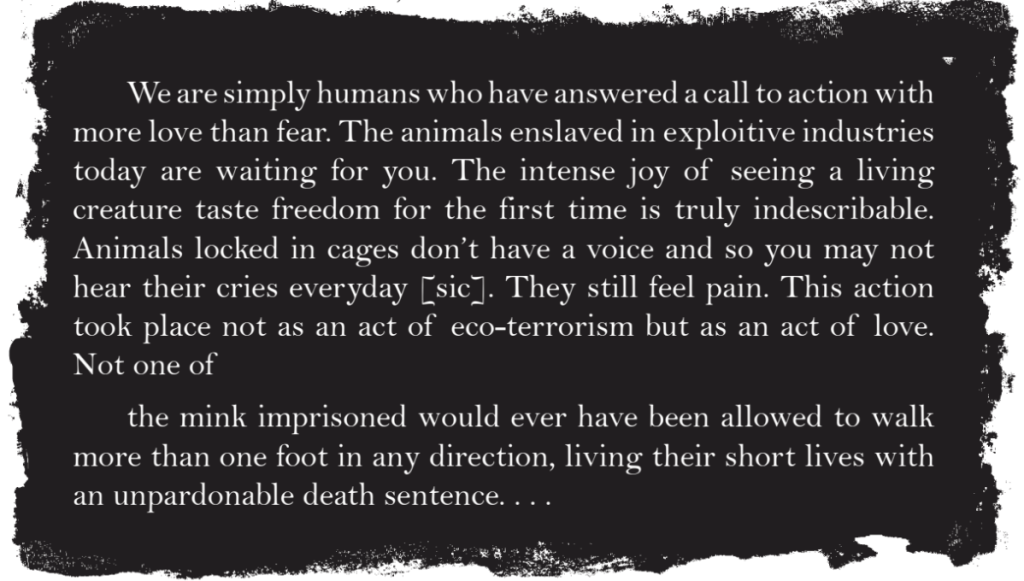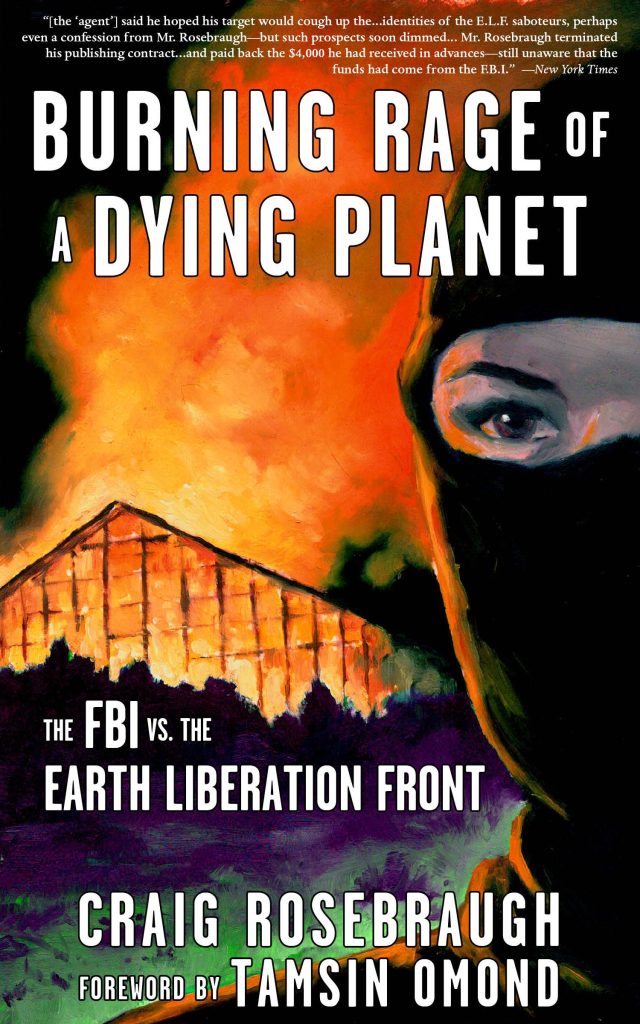Burning Rage of a Dying Planet: The FBI vs. the Earth Liberation Front
An insider’s view of radical environmentalism
Since the mid-1990s, the secretive cell organization calling itself the Earth Liberation Front (ELF, or Elves) has waged a brazen campaign of property damage and arson attacks against entities they hold responsible for environmental destruction, including timber companies, ski resorts, slaughterhouses, and car dealerships.
In Burning Rage of a Dying Planet: The FBI vs. the Earth Liberation Front, former ELF spokesperson Craig Rosebraugh charts the history and ideology of the ELF, as well as the repression strategies the government uses to destroy activist movements—including tactics we continue to see wielded against global liberation movements today. Rosenbraugh himself was the subject of a shocking New York Times article last year detailing the efforts of an informant connected to the FBI and the CIA to draw him into a book contract designed never to reach publication, but which provided authorities the opportunity to comb his drafts for clues that might help them apprehend ELF conspirators. Rosenbraugh, though, only ever transmitted anonymous communiques, and when he made a discovery about the man posing as his “book packager” that he writes “made my heart race, made my breath vanish, and sent me off to gather every weapon I had in my house,” the project came to an uneasy end.
Luckily, Rosenbraugh was still determined to let his story see the light of day after this harrowing ordeal, and the book was originally published in 2004. Twenty years later, Microcosm is proud to release this revised and updated edition, featuring a new foreword from Extinction Rebellion co-founder Tamsin Osmond. Burning Rage remains a valuable and illuminating insider account of the ongoing battle between radical environmentalist movements and the powers of the state; one that offers frank insight into the great personal cost of political action, but also the urgency of collective resistance to capitalist violence.
Read on for an excerpt of Burning Rage of a Dying Planet: The FBI vs. the Earth Liberation Front by Craig Rosenbraugh, now available for preorder from our site or from your local bookseller. Out everywhere 7/9/24.
The ALF Makes Contact
Late that spring, the call came. “Check your mailbox,” the rough-voiced caller said sternly, without identifying himself. When the phone awakened Vanessa that morning, she thought at first it was a joke, a disturbing prank. But when the caller repeated the message, she began to feel it might be serious, even urgent. Still half asleep, not knowing what to do, or even whether the call had been real, she awakened Leslie, then knocked on my bedroom door. “Craig . . . Craig,” she whispered. I awakened in a daze.“ Someone with a weird voice just called and told us to check our mailbox.” Unable to register her words at that early hour, I rolled over and closed my eyes again. Leslie and Vanessa went down tothe porch and checked the mailbox, where sure enough, a notewas waiting. Shocked, they brought it upstairs and showed it tome. With the first words on the page, my heart began pounding.I could barely believe my eyes. The distorted writing stated thatthe Animal Liberation Front (ALF) was taking responsibility for the release of 12,000 mink from a fur farm in Mt. Angel, Oregon. The date of the action listed on the page was May 30, 1997. The communiqué stated:

I read it over and over. “Holy shit!” I said. “Do you think it’s real?” Leslie asked. “I have no idea,” I admitted. “I don’t know why this would be a fake message, though.” By now Casea and Josh had been awakened by the excitement and had joined us in the upstairs hallway. Neither of them could believe the message we had just received. Why did they pick us? How did they know our address and phone number? We figured that whoever had left this message and called had most likely obtained the Cleveland House address and telephone number from our promotional materials for the Against Animal Testing conference earlier in the year. Was it someone who was at the conference? I couldn’t help but wonder. Maybe they even stayed in this house. We all reminded ourselves that it could have been anyone, as the conference information with our home address and phone number had reached a thousand or more people across the United States. “What should we do?” Leslie asked. All five of us stared at each other for a moment. At that point, I knew we were going to have to make a decision. I had read about the spokesperson work that individuals such as Robin Webb and Rod Coronado had done for the ALF, in England and the US respectively. Now we were faced with a decision that I knew would be important not only for the ALF but for all of us in the house. Either we could pretend that this note had never come to us, or we could alert the news media and try to explain the underlying rationale for the ALF mink raid.The news stories that we might be able to stir up by releasing the message could be priceless for the ALF and the animal rights movement. The media exposure could provide a promising opportunity for publicizing the objectionable practices of the fur industry. Just as many consumers really don’t want to know where their meat comes from (other than a nice cellophane package in the local grocery store), the public also avoids the truth about the fur industry—for example, that the typical mink coat contains an average of forty dead mink, and that the primary modes of killing the fur-bearing animals on the farm are gassing, neck breaking, and anal electrocution. If any or all of these facts could get into even one news story, we felt that our press release could be beneficial to the animal rights cause. My own feeling was that if these people—whoever they might be—had in fact conducted the mink raid, the public needed to know that there are people who are sufficiently concerned about the fur industry, motivated to commit illegal actions to further their beliefs. They had a right to know that the liberation had not been a random act of lawlessness. It had a clear political and social motive, which people needed to be able to consider as they developed their own opinions on the issue. Finally, taking the communiqué to the press allowed the issue to be brought out into the open, where ideally proponents and opponents could work toward a resolution.
. . . . Feeling certain that we had made the right decision to release the ALF communiqué, none of us in the house stopped for more than a moment to consider that the communiqué we had received could be one of the only pieces of evidence available for a future law enforcement investigation. We didn’t think about the fact that we could be investigated ourselves—or, if we did, those thoughts were overshadowed by the excitement and sense of duty we felt to release the information. Early the next morning, I gathered up the copies of the press release and communiqué and headed downtown. I had scheduled the conference to begin at 10:00 A.M. in order to get a story on the 12:00, 5:00, and 11:00 news. I really didn’t know what to expect as far as the turnout was concerned. My primary experience thus far had been with Liberation Collective events and protests, where two media sources would show up if we were lucky. (Out of these two, one was usually the community radio station, KBOO—we always appreciated their consideration of our work as news.) I expected much the same this time, although J.P. had suggested to me the day before that this could be a big story.
. . . . The news story was much larger than I had anticipated. It was reported locally in Portland throughout the rest of the dayon television, and radio stations in the area also broadcast it as a featured news item. The next morning,The Oregonian (Oregon’s largest daily newspaper) ran a sizable piece on the action, including quotes from me at the press conference. Overall, every story I saw was biased, in the sense that the writers referred to the ALF as criminals or vandals. Yet, in addition to the reporters’ editorial comments, each story seemed to contain at least some information on the ALF and its motivation for the action. I felt pleased and hoped that others, including those in the ALF, would be happy with the coverage.Following the decision to distribute and publicly support this ALF action, I came to be considered one who could be counted on for future press work. In the next several months, more anonymous communiqués from the ALF began to come my way. After this first experience, little thought went into deciding whether or not I would release subsequent communiqués from the ALF. As my philosophical support of the underground organization continued to grow, so did my willingness to support them publicly. As it turned out, however, this debut as a spokesperson for the ALF would lead me down roads I had never thought possible.
Want to keep reading? Check out Burning Rage of a Dying Planet: The FBI vs. the Earth Liberation Front by Craig Rosenbraugh, available everywhere 7/9/24.
